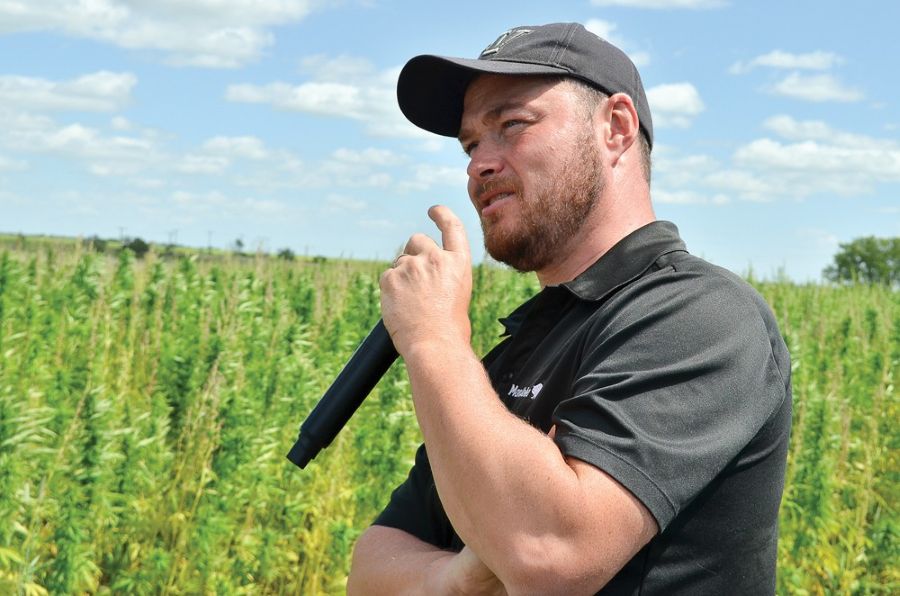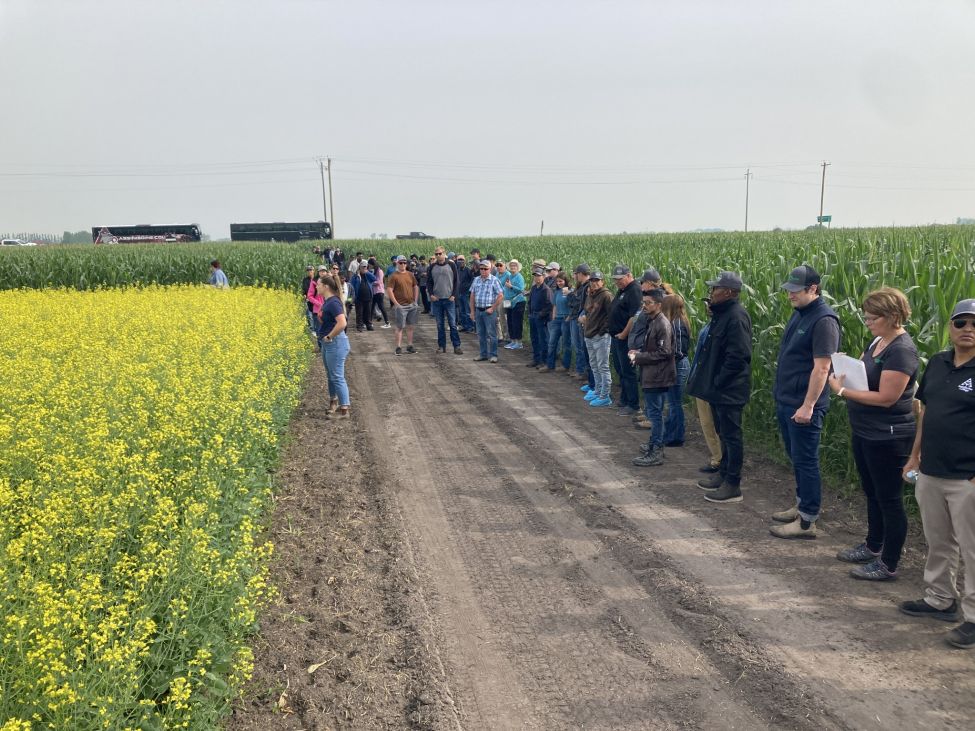Farmers and other stakeholders in the Ag industry have been attending Field Days with Manitoba Agriculture across the region, with today's taking place in Carberry with the Manitoba Crop Diversification Centre. Yesterday, Field Day participants toured test plots in Roblin facilitated by the Parkland Crop Diversification Foundation. Prior to these on July 30th, Arborg hosted their annual Field Day through the Prairie Sustainable Agriculture Initiative Group.
For the Westman Agricultural Diversification Organization (WADO) Field Day a few weeks ago in Melita, event coordinator and Applied Research Specialist, Scott Chalmers says the day pretty much perfect.

"I don't think I've ever had such a nice day for a field day. It was about 22 degrees, partly cloudy, barely a breeze really. And you know, the guests really enjoyed that. Most of all, we had great speakers to come out and talk about each of the projects that we wanted to showcase and kind of show the crowd what we're looking for. There are things that the crowd can see first-hand when the speakers discuss each project."
What's happening with the canola?
Kendall Baker from Manitoba Canola Growers Association discussed the different variety trials at the Melita test plots. Chalmers says this year's canola trials are fairly large. "There are three passes long for us and that's kind of a big plot. And so, we're going to get some really nice yields and some of those canola plots are right up to my nose in height. We're hoping to hit a good 60-bushel acre there."
In addition to the canola trials Baker also discussed bug traps that are catching bugs that hang around canola.
"There's a program headed by Adele Perez Lopez at Laval University in Quebec and they have a program called Leaf Hope looking at these bugs and understanding who's showing up at what time. So, we have to change these bug traps every week. And they're in particular looking for a midge that's affecting canola recently. And so, we're looking forward to hearing about that at the end of the year."
What's being studied with corn?
Dr. Loveleen Kaur Dhillon from the University of Manitoba also presented. Dhillon is with the Mantle Crop Alliance as an agronomist in residence at the University of Manitoba.
"She talked about her critical weed free period trial in corn," explains Chalmers. "And so, we're trying to understand what is the best time to get rid of the weeds in corn? And so, we have all these different spray treatments at different timings of the corn.
In mid-July they were spraying the corn trials. "And of course, the corn is over my head and the weeds inside these plots are enough to fill a garbage bag in a meter square area. And so, we've been taking all these weeds to U of M to get weighed, characterized and dried down."
Morgan Cott from Mandeville Crop Alliance talked about the corn variety trial.
"With each trial she provided some really cool insights about what to look for in corn trials like the grain moisture," explains Chalmers. "For example, some varieties mature later than others and therefore they would have higher moisture levels, which is a cost to the producer for drying costs. And you know the drier that grain can be, the higher yield, the better. That's kind of what was discussed."
What's new with the Greenhouse Gas project?
Dr. Manasah Mkhabela from the University of Manitoba discussed the greenhouse gas project at the WADO test plots.
"Last year it was with wheat, and this year now it's with flax in the same spot. And we're trying to understand the behavior and efficacy of nitrification inhibitors," says Chalmers. "These are things like Ntrench and Super U or Agrotain that we put on our fertilizer to reduce greenhouse gases and maximize their effectiveness on the crop. And he provided results from 2024's wheat crop that were quite dramatic here at WADO, right from the Melita site and very promising with the one product Ntrench that we have."
"And we're really looking forward to this year in flax with the same treatments," he adds.
What's happening at the broadleaf sites?
"This is where we have peas and hemp and soybeans and dry beans, all kinds of stuff. And we had various speakers there. We had Anand Aneja, research agronomist from Assiniboine College talk about pea leaf weevils, and Wendy McDonald from the Manitoba Pulse and Soybean Growers. She's our Western agronomist now. She talks all about dry beans and how to grow dry beans properly. And this is kind of a nuance to the Western growers here cause normally we're not dry bean growers, but there's actually quite a few acres on this side of the province this year, and there were lots of great questions there."
"Another bean expert we had was Kristen McMillan from the University of Manitoba. We have a project with her dealing with dry bean inoculant, and we also have that kind of in conjunction with application of nitrogen. She talked about our 2024 results from Melita, which again were quite unique compared to Red River results showing great promise for inoculation and dry bean out on the western side here."
Assiniboine College student, Samantha Teal shared on their project with bio stimulants in soybean. "This is to do with things like humic acids or compost teas and even charcoal as treatments," says Chalmers. "And so, we're really kind of looking forward to how that all pans out at harvest here."
The presentations were concluded with Jeff Kostuik and Raleigh Jurek from Verve Seeds talk about their hybrid hemp and different things about like the industry approvals, the breeding process and what their goals are in developing their company, says Chalmers.
"So, we have two different projects there, one looking at the hybrids, the other one looking at things like nitrogen use and seeding rates."
We're seeing more corn and dry beans in the southwest corner of the province.
"And you know, I don't know if we're just getting good at farming, but you know, corn and dry beans in the western side were probably never really a thing until the last ten years here. And I think it has to do with some of our breeding programs going on that are developing these varieties that are more suited for the western area," he explains, "whether it's for cold tolerance in corn or some sort of stature or earliness to maturity in dry beans."
"We've got some really good breeding programs going on with corn and possibly we're just getting kind of warmer in the climate here that we are able to actually finish corn. Last year we had corn that was dry for moisture in the green in the plots last year, and that's very promising if you can just take it straight to the elevator without drying it."
"And dry bean, well our bean markets are kind of opening up as well," he adds. "We've got all kinds of different kinds of beans, cranberries, pintos, navies, blacks, all kinds. And you know, we're getting better and better at this as we get more experience with the crop. And if we can have something like an inoculant that we can apply on dry beans that would be a substantial cost savings for the western side here if we can pull that off."
What caught your attention?
"I think what it was is some of these speakers brought some of the results from last year and brought them kind of to the table so that people could understand really what the results were right here in Melita and how that might reflect on what they're actually seeing in front of them for their own eyes," answers Scott Chalmers. "And when we get multiple site years of data coming in that keep telling us the same thing. We can say for sure, you know, this is probably the case. You know, whatever that conclusion is, the odds are in favor of whatever that is happening. And that's the power of the data."
"Not only is it replicated here, but it's also unbiased and it could be multiple site years that we can combine in some sort of statistical analysis to make a grand conclusion," he adds. "And that's very powerful for the farmer and the economics in the region."
